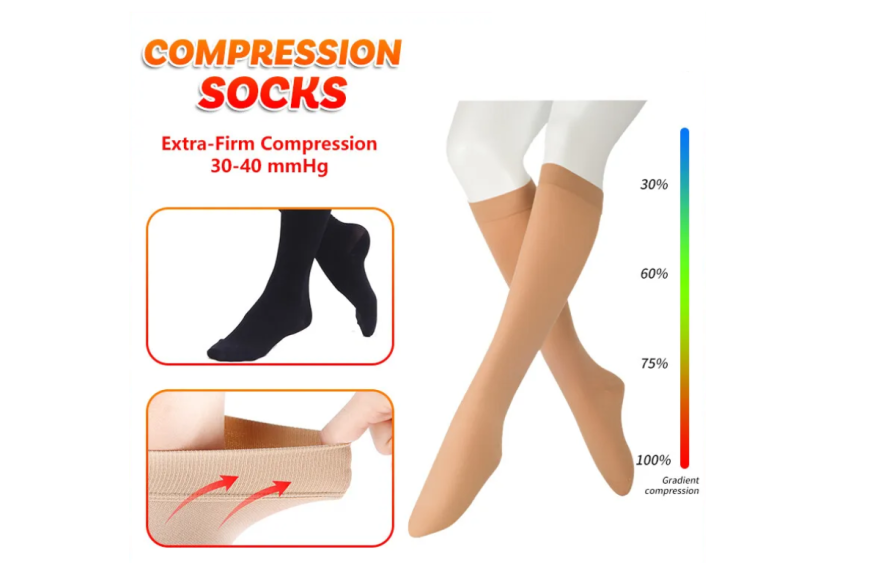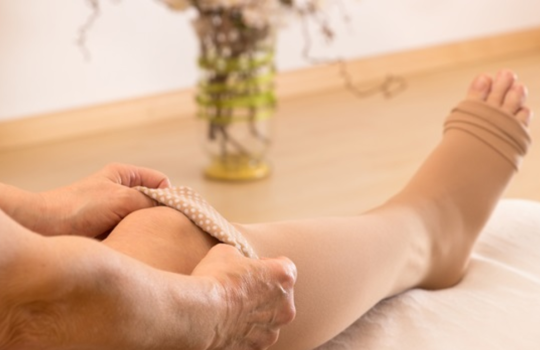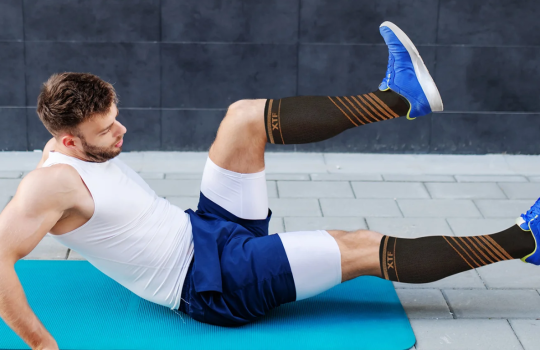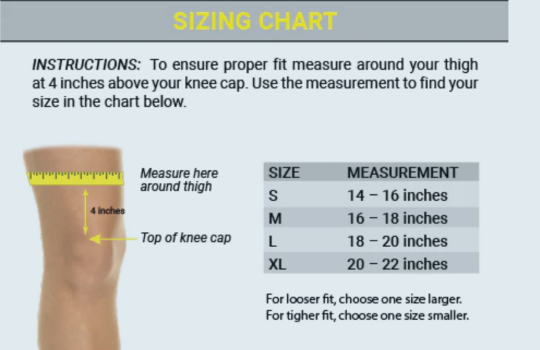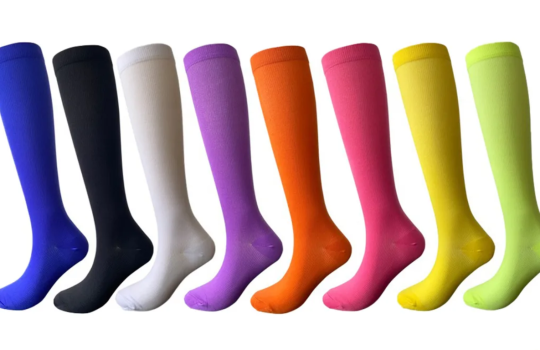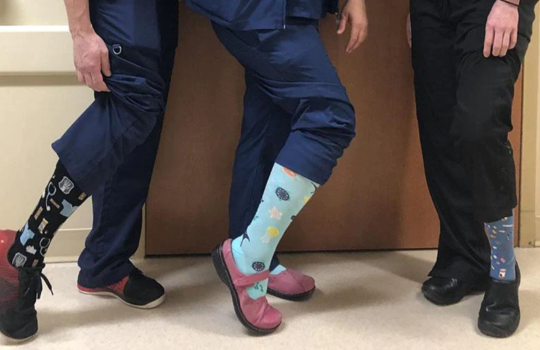Table of Contents
Introduction
Should you find yourself in the state of pregnancy, you might observe shifts in the condition of your legs and feet. Swelling, pain, a sense of heaviness, cramps, and the emergence of varicose veins could become noticeable. These symptoms are common indications of compromised blood circulation and fluid retention, potentially affecting your comfort and well being during pregnancy.
A straightforward and efficient method to enhance blood flow and minimize swelling involves the use of compression socks. These specialized socks are designed to gently exert pressure on your legs, assisting in preventing the accumulation of fluids and promoting the return of blood towards the heart. This can notably alleviate your discomfort and reduce the risk of complications like blood clots.
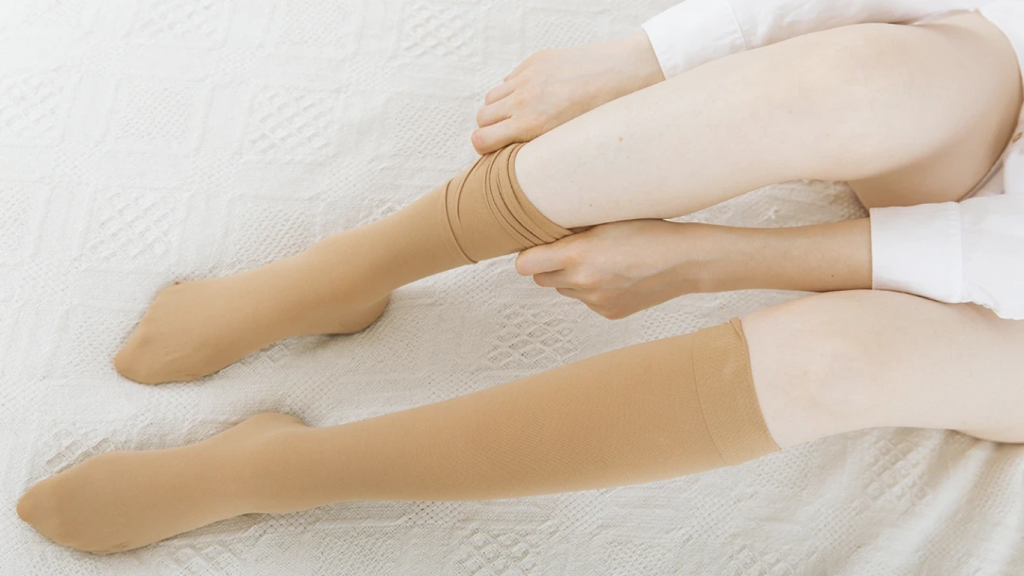
Ready to dive deeper into compression socks? Discover more in our guide on Compression Socks. Elevate your knowledge and embrace the benefits they offer.
In this blog article, we will delve into the advantages of utilizing compression socks during pregnancy, provide guidance on selecting the appropriate ones for your needs, and furnish instructions on the correct way to don them. Additionally, we will introduce some of the best compression socks for pregnancy that are available for purchase online.
Managing Pregnancy Challenges with Compression Socks
Looking for more information about compression socks? Check out our comprehensive guide on compression socks near me to discover everything you need to know. From benefits to finding the perfect fit, we’ve got you covered.
Compression socks during pregnancy offer a means to manage prevalent challenges that often accompany pregnancy, such as:
Edema Relief with Compression Socks
Edema is the medical term for swelling caused by excess fluid trapped in your tissues. Edema affects approximately 70% of pregnant women during the third trimester and can make your legs and feet feel heavy, tight, achy or numb. Compression socks can help reduce edema by preventing fluid from pooling in your lower limbs and improving lymphatic drainage.
Varicose Vein Prevention and Treatment
Varicose veins, characterized by twisted and enlarged veins appearing under skin usually on the leg are a consequence of increased blood volume and hormonal shifts that weaken vein valves. These veins can be painful, itchy, or aesthetically displeasing. Through the promotion of blood circulation and support for vein walls, compression socks during pregnancy can serve to prevent or treat varicose veins.
Preventing Deep Vein Thrombosis (DVT)
Deep Vein Thrombosis (DVT) is a life threatening condition in which blood clots form within deep veins in the leg, often manifested by swelling, pain, redness or warmth in that area. If dislodged from its original location it could travel through veins into lungs resulting in PE (pulmonary embolism).Pregnant women face increased risks for DVT due to hormonal changes and reduced mobility, using compression socks during pregnancy can help by increasing blood flow through veins to avoid stagnation and stopping stagnation within veins thereby helping DVT prevention by increasing blood flow within veins thereby improving blood flow while also preventing stagnation within veins thereby helping avoid it altogether.
Alleviating Leg Cramps
Leg cramps, sudden and involuntary contractions of leg muscles, manifest as sharp pain and stiffness. These cramps are more prevalent during pregnancy due to changes in calcium and magnesium levels, dehydration, or nerve compression. Compression socks contribute to alleviating leg cramps by facilitating enhanced blood supply and delivery of oxygen to muscles.
Reducing Fatigue
The sensation of fatigue, encompassing weariness and exhaustion impacting both physical and mental performance, is a common experience during pregnancy. This is attributable to hormonal shifts, heightened energy demands, and disruptions in sleep patterns. By augmenting blood circulation and oxygen transport throughout body, compression socks during pregnancy can help diminish feelings of fatigue.
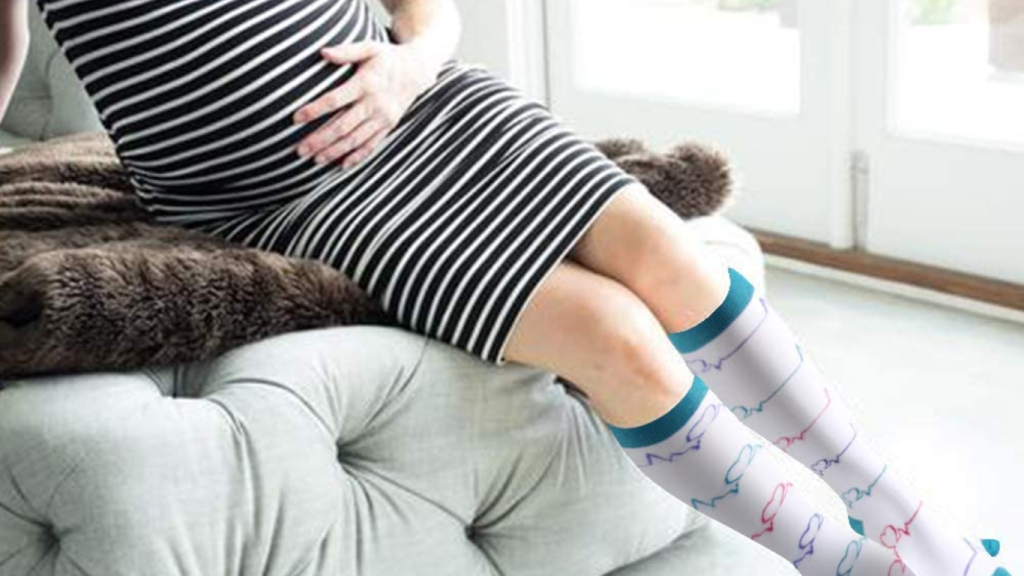
Supplementary Benefits for Expectant Mothers
In addition, compression socks might offer supplementary benefits to expectant mothers, including:
- Mitigating dizziness linked to early pregnancy nausea and vomiting when worn during initial stages
- Enhancing posture and balance by stabilizing ankles and feet
- Providing support and style for augmented comfort and confidence
Choosing the Best Compression Socks for Pregnancy
To recap the advantages of compression socks during pregnancy, making a suitable choice is crucial. Here are key factors to consider while shopping for compression socks:
Selecting the Optimal Compression Level
Compression level, measured in millimeters of mercury (mmHg), signifies pressure exerted by the socks on your legs. A higher compression level implies greater pressure. Most experts recommend a mild to moderate compression level of 15-20 mmHg or 20-30 mmHg for pregnancy. This range suffices to enhance blood flow and diminish swelling without causing discomfort or constraining blood circulation. It’s advisable to avoid higher compression levels unless recommended by a medical professional.
Ensuring the Correct Size
Selecting the correct size is paramount for efficacy and comfort of compression socks. Socks that are excessively small could result in pain, numbness, or skin irritation. Conversely, socks that are excessively large may slip down or bunch up, compromising their effectiveness and generating irritation. To determine your size, measure the circumference of your ankle and calf, along with length from heel to knee. Then, compare your measurements with manufacturer’s or seller’s size chart.
Exploring Various Styles for Comfort
Style depends on personal desire and comfort. There are several different types of compression socks, including knee high, thigh high, and pantyhose. Knee high socks work well during pregnancy and are simpler to put on and take off than other types. If swelling or varicose veins reach above knee, you could choose from an assortment of thigh high socks or pantyhose. Each hue, pattern and style has something special for every style and attire imaginable.
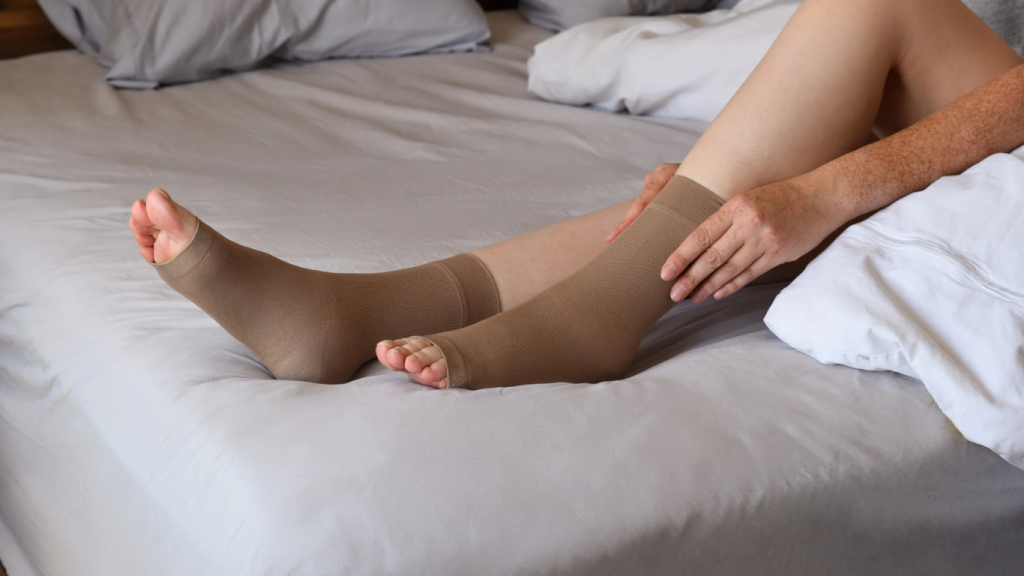
Assessing Materials for Durability and Comfort
Material impacts durability, breathability, and comfort of compression socks. These socks usually consist of synthetic fabrics like nylon, spandex, Lycra, or polyester, which contribute elasticity and strength. Some socks incorporate natural fibers like cotton or wool to enhance softness and warmth. Certain socks may even incorporate copper or silver, possessing antibacterial and odor resistant properties. opt for socks that are smooth, stretchable, moisture wicking, and easy to launder.
Effective Application of Compression Socks During Pregnancy
For optimal results from compression socks during pregnancy, correct and consistent usage is essential. The following guidelines outline how to wear compression socks effectively:
Morning Application for Maximum Benefit
The ideal time to don compression socks for pregnancy’s is in morning, prior to any swelling in legs and feet. This practice helps prevent fluid accumulation throughout day and simplifies process of putting on the socks. In the event that you don them later in the day, consider elevating your legs briefly to reduce swelling before donning socks.
Employing the Rolling Technique for Easy Wear
The most straightforward approach to wearing compression socks during pregnancy is to roll them up from toe to the ankle, then gently slide your foot into them before unrolling them up your leg. Alternatively, you can use tools like a sock aid or a zipper to facilitate the process. Avoid excessive pulling or stretching, as this could harm fabric and diminish compression effect.
Ensuring a Proper and Comfortable Fit
Upon putting on socks, ensure they rest evenly and snugly on your legs. Wrinkles, folds, or gaps should be eliminated, as they could lead to discomfort or reduce efficacy of compression. Top of the socks should remain below knee and not roll down or dig into skin.
Nighttime Removal for Rest and Comfort
Unless directed otherwise by your healthcare provider, it’s advisable to remove compression socks before sleeping. This enables your legs and feet to rest and breathe. If you experience any pain, numbness, tingling, itching, or skin changes while wearing compression socks, promptly remove them and consult a medical professional if symptoms persist.
Regular Cleaning to Maintain Performance
Maintaining the cleanliness, elasticity, and compression of your socks requires regular washing. Adhere to care instructions on sock’s label, generally involving hand washing in cold water with mild soap, followed by air drying
Conclusion
Wearing compression socks during pregnancy offers notable benefits, including improved blood flow, reduced swelling, and prevention of various discomforts and complications. Choosing the right compression level, size, style, and material is essential for optimal results. Proper usage, including morning application and nighttime removal, along with regular washing, ensures their effectiveness. Compression socks can be a valuable addition to your pregnancy routine, enhancing comfort and overall well being. Before using them, always consult with your healthcare provider.
FAQs
Are compression socks safe to wear during pregnancy?
Yes, compression socks are generally safe to wear during pregnancy. However, it’s advisable to consult with your healthcare provider before using them, especially if you have any underlying medical conditions.
When should I start wearing compression socks during pregnancy?
You can start wearing compression socks as soon as you notice any discomfort, swelling, or varicose veins in your legs. Many women begin wearing them in the second trimester when these symptoms tend to become more noticeable.
What level of compression should I choose?
Most experts recommend mild to moderate compression levels, typically ranging from 15-20 mmHg to 20-30 mmHg, for pregnancy. This level of compression effectively improves blood flow and reduces swelling without causing discomfort.
Can I wear compression socks at night?
It’s generally recommended to remove compression socks at night to allow your legs to rest and breathe. Consult your healthcare provider for specific guidance based on your situation.
Can I wear compression socks with dresses and skirts?
Yes, compression socks come in various styles and colors, including knee high designs that can be worn discreetly under dresses and skirts.
Will compression socks help with back pain during pregnancy?
While compression socks primarily target leg related discomfort, they can indirectly contribute to overall improved blood circulation, which might help with some general discomforts including back pain.
How often should I wash my compression socks?
Washing frequency depends on usage and personal preference. Generally, washing them after a few wears is recommended to maintain their elasticity and effectiveness. Follow the care instructions provided by the manufacturer.
Can I wear compression socks during exercise?
Yes, you can wear compression socks during exercise, as they can help support blood circulation and reduce muscle fatigue. However, it’s important to ensure that the level of compression is appropriate for your activity level.
Are there any situations where I shouldn’t wear compression socks?
If you have certain medical conditions such as advanced peripheral artery disease or skin infections, compression socks might not be suitable. Consult your healthcare provider to determine if compression socks are right for you.
Do I need a prescription to buy compression socks?
In many cases, you don’t need a prescription to purchase compression socks. However, if you have specific medical concerns, it’s a good idea to consult your healthcare provider before making a purchase.

